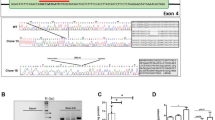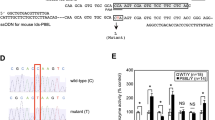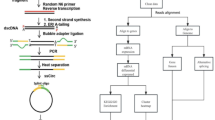Abstract
A deficiency of the enzyme iduronate-2-sulfatase (IDS) is the cause of Hunter syndrome (mucopolysaccharidosis type II). Here, we report a study of the human IDS locus at Xq28. An unexpected finding was an IDS-related region (IDS2) which is located on the telomeric side of the IDS gene within 80 kb. We have identified sequences in this locus that are homologous to exons 2 and 3 as well as sequences homologous to introns 2, 3 and 7 of the IDS gene. The exon 3 sequences in the IDS gene and in the IDS2 locus showed 100% identity. The overall identities of the other identified regions were 96%. A locus for DXS466 was also found to be located close to IDS2. The existence of the IDS2 locus complicates the diagnosis of mutations in genomic DNA from patients with Hunter syndrome. However, information about the IDS2 locus makes it possible to analyze the IDS gene and the IDS2 locus separately after PCR amplification.
Similar content being viewed by others
Log in or create a free account to read this content
Gain free access to this article, as well as selected content from this journal and more on nature.com
or
References
Neufeld EF, Muenzer J: The mucopolysaccharidoses; in Scriver CR, Beaudet AL, Sly WS, Valle D (eds): The Metabolic Basis of Inherited Disease. New York, McGraw-Hill, 1989, pp 1565–1587.
Bielicki J, Freeman C, Clements PR, Hopwood JJ: Human liver iduronate-2-sulphatase: Purification, characterization and catalytic properties. Biochem J 1990;271:75–86.
Wilson PJ, Morris CP, Anson DS, Occhiodoro T, Bielicki J, Clements PR, Hopwood JJ: Hunter syndrome: Isolation of an iduronate-2-sulfatase cDNA clone and analysis of patient DNA. Proc Natl Acad Sei USA 1990;87:8531–8535.
Upadhyaya M, Sarfarazi M, Bamforth JS, Thomas NST, Oberlé I, Young I, Harper PS: Localisation of the gene for Hunter syndrome on the long arm of the X chromosome. Hum Genet 1986;74:391–398.
Thomas NST, Roberts SH, Upadhyaya M, Knight S, Harper PS: Physical localization of the X;autosomal translocation breakpoint from a girl expressing Hunter syndrome using Xq27-Xq28 markers. Cytogenet Cell Genet 1989;51:1090.
Suthers GK, Hyland VJ, Callen DF, Oberlé I, Rocchi M, Thomas NS, Morris CP, Schwartz CE, Schmidt M, Ropers HH, Baker E, Oostra BA, Dahl N, Wilson PJ, Hopwood JJ, Sutherland GR: Physical mapping of new DNA probes near the fragile X mutation (FRAXA) by using a panel of cell lines. Am J Hum Genet 1990; 47:187–195.
Suthers GK, Oberlé I, Nancarrow J, Mulley JC, Hyland VJ, Wilson PJ, McCure J, Morris CP, Hopwood JJ, Mandel JL, Sutherland GR: Genetic mapping of new RFLPs at Xq27-q28. Genomics 1991;9:37–43.
Suthers GK, Mulley JC, Voelckel MA, Dahl N, Väisänen ML, Steinbach P, Glass IA, Schwartz CE, van Oost BA, Thibodeau SN, Haites NE, Oostra BA, Giné R, Carballo M, Morris CP, Hopwood JJ, Sutherland GR: Genetic mapping of new DNA probes at Xq27 defines a strategy for DNA studies in the fragile X syndrome. Am J Hum Genet 1991;48: 460–467.
Wilson PJ, Suthers GK, Callen DF, Baker E, Nelson PV, Cooper A, Wraith JE, Sutherland GR, Morris CP, Hopwood JJ: Frequent deletions at Xq28 indicate genetic heterogeneity in Hunter syndrome. Hum Genet 1991;86:505–508.
Palmieri G, Capra V, Romano G, D’Urso M, Johnson S, Schlessinger D, Morris P, Hopwood JJ, DiNatale P, Gatti R, Ballabio A: The iduronate sulfatase gene: Isolation of a 1.2-Mb YAC contig spanning the entire gene and identification of heterogeneous deletions in patients with Hunter syndrome. Genomics 1992; 12:52–57.
Flomen RH, Green EP, Green PM, Bentley DR, Giannelli F: Determination of the organisation of coding sequences within the iduronate sulphate sulphatase (IDS) gene. Hum Mol Genet 1993;2:5–10.
Wilson PJ, Meaney CA, Hopwood JJ, Morris CP: Sequence of the human iduronate-2-sulphatase (IDS) gene. Genomics 1993;17:773–778.
Hopwood JJ, Bunge S, Morris CP, Wilson PJ, Steglich C, Beck M, Schwinger E, Gal A: Molecular basis of mucopolysaccharidosis type II: Mutations in the iduronate-2-sulphatase Gene. Hum Mutat 1993;2: 435–442.
Bondeson ML, Dahl N, Malmgren H, Kleijer WJ, Tönnesen T, Carlberg BM, Pettersson U: Inversion of the IDS gene resulting from recombination with IDS-related sequences is a common cause of the Hunter syndrome. Hum Mol Genet 1995;4: 615–621.
Steén-Bondeson ML, Dahl N, Tönnesen T, Kleijer WJ, Seidlitz G, Gustavson KH, Wilson PJ, Morris CP, Hopwood JJ, Pettersson U: Molecular analysis of patients with Hunter syndrome: Implication of a region prone to structural alterations within the IDS gene. Hum Mol Genet 1992;1:195–198.
Lehrach H, Drmanac R, Hoheisel JD, Larin Z, Lennon G, Monaco AP, Nizetic D, Zehetner G, Poustka, A: Genetic and physical mapping; in Davies KE, Tilghman SM (eds): Genome Analysis. Cold Spring Harbor, Cold Spring Harbor Laboratory Press, 1990, vol 1, pp 39–81.
Nizetic D, Zehetner G, Monaco AP, Gellen L, Young BD, Lerach H: Construction, arraying, and highdensity screening of large insert libraries of human chromosomes X and 21: Their potential use as reference libraries. Proc Natl Acad Sci USA 1991;88:3233–3237.
Sanger F, Nicklen S, Coulson AR: DNA sequencing with chain-terminating inhibitors. Proc Natl Acad Sei USA 1977;74:5463–5467.
Steglich C, Bunge S, Hulsebos T, Beck M, Brandt NJ, Schwinger E, Hopwood JJ, Gal A: Molecular analysis in patients with mucopolysaccharidosis type II suggests that DXS466 maps within the Hunter gene. Hum Genet 1993;92:179–182.
Hu X, Worton RG: Partial gene duplication as a cause of human disease. Hum Mutat 1992;1:3–12.
Gitschier J: Maternal duplication associated with gene deletion in sporadic hemophilia. Am J Hum Genet 1988;43:274–279.
Rathmann M, Bunge S, Steglich C, Schwinger E, Gal A: Evidence for an iduronate-sulfatase pseudogene near the functional Hunter syndrome gene in Xq27.3-q28. Hum Genet 1995;95:34–38.
Acknowledgements
We thank J.J. Hopwood, P.J. Wilson and CP. Morris for the probe pB2Sc17 and for sharing data prior to publication. We also thank M. D’Urso and G. Palmieri for kindly providing the YAC clones and Ann-Sofie Engström for assistance with the sequencing. This work was supported by grants from the Swedish Medical Research Council, the Beijer Foundation and the Marcus Borgström Foundation.
Author information
Authors and Affiliations
Rights and permissions
About this article
Cite this article
Bondeson, ML., Malmgren, H., Dahl, N. et al. Presence of an IDS-Related Locus (IDS2) in Xq28 Complicates the Mutational Analysis of Hunter Syndrome. Eur J Hum Genet 3, 219–227 (1995). https://doi.org/10.1159/000472302
Received:
Revised:
Accepted:
Issue date:
DOI: https://doi.org/10.1159/000472302
Key Words
This article is cited by
-
LCR-initiated rearrangements at the IDS locus, completed with Alu-mediated recombination or non-homologous end joining
Journal of Human Genetics (2011)
-
Molecular analysis of the iduronate‐2‐sulfatase gene in Thai patients with Hunter syndrome
Journal of Inherited Metabolic Disease (2008)
-
Multiple cryptic splice sites can be activated by IDS point mutations generating misspliced transcripts
Journal of Molecular Medicine (2006)
-
Pathological Consequences of Sequence Duplications in the Human Genome
Genome Research (1998)



